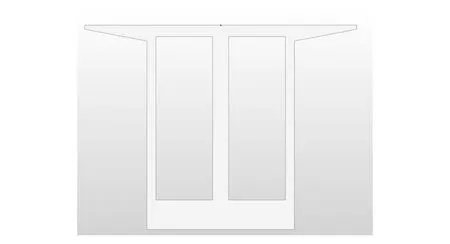Mechanical Properties of Cross-Sections of High-Pier Bridges in Complex Working Conditions*
2022-02-17WANGJianxingZHANGZhaoweiLIUGeZHANGZihengYUZhihan
WANG Jianxing,ZHANG Zhaowei,LIU Ge,ZHANG Ziheng,YU Zhihan
(College of Civil Engineering,North China University of Technology,Beijing 100144,China)
Abstract:Based on the actual project of Luohe Bridge,the Midas Civil software was used to establish a model of the high-pier bridge under the design load,and the mechanical properties of the two types of cross-sectional high-pier continuous steel-concrete frame bridge were analyzed under different load combinations.In working conditions 1 and 3,the bearing capacity of type A cross-section is higher than that of type B structure,and the maximum axial stress is reduced by 28.54% and 27.88% respectively.In working condition 3,the maximum deflections of A-type and B-type high pier bridges are 3.953 mm and 3.643 mm respectively.The deflection of an A-type bridge is 7.84% lower than that of a B-type bridge.The structural stiffness of A-type high pier bridge is improved and the structural deformation is reduced.In all kinds of working conditions,the stress of a high pier bridge meets the strength requirements.
Key words:high-pier bridge;mechanical properties;prestressed concrete;numerical analysis
With the development of the economic construction and the deepening of traffic roads in China,the new traffic construction is often inseparable from crossing ravines and ditches,which requires mainly the bridge structures.A high-pier bridgehas structural problems such as high flexibility of pier and large weight of the topside structure,making it easy to form an adverse seismic system.Therefore,the seismic safety of high-pier bridges has attracted extensive attention.Scholars at home and abroad have also carried out various researches on the structural design of high pier bridges from different perspectives.Among them,the domestic scholars mostly studied the bridge seismic and worked on structural optimization,dynamic response,stability analysis,etc[1-5];while the foreign scholars mainly analyzed the interaction between structural design and soil mass[6-8].With the improvement of highway engineering technology,when building roads in mountainous areas with large surface elevation difference,the bridge design inevitably faces the difficulties of crossing high elevation difference areas such as river valleys and ravines.To ensure the safe use of high-pier bridges,the study of the bridge cross-section structure and mechanical properties becomes particularly important.The current design of domestic high-pier bridges is relatively conservative,resulting in the excessive consumption of concrete and reinforcement and a low material utilization rate.The reasonable design of the bridge cross-section can not only effectively solve the above problems,but also reduce the thickness of the concrete slab to reduce its weight,which is more conducive to the construction.Therefore,it is particularly necessary to study the mechanical properties of the cross-section of a high-pier bridge.Based on the software modeling of the main bridge structure of Luohe Bridge,this paper studies the mechanical properties of beam bridges with different cross-section structures and gives corresponding engineering suggestions.
1 Project Overview
The Luohe Bridge is located on the expressway in Yan'an City,Shaanxi Province,China,with a length of 300.00 m,a bridge deck width of 12 m,and a pier structure height of 90 m,with the typical properties of a high pier and large span.It adopts the steel-concrete composite single-cell box girder structure.The main body of the bridge is the cast-in-place concrete pile bridge abutment plinth.The main bridge pier adopts the double thin-walled hollow pier and adopts the longitudinal,transverse and vertical prestress system.The prestressed box girder bridge composed of two single cell box girder sections the upstream and downstream is the main topside component of the main bridge,and the beam height between the bridge decks changes at a quadratic function.The cross sections of the two types of high-pier bridges are shown in fig.1 and fig.2.

Fig. 1 High-Pier Bridge Cross-Section Type A

Fig. 2 High-Pier Bridge Cross-Section Type B
In this paper,the bridge materials are the C60 concrete commonly used in practical engineering,the topographic and geological conditions are set as ideal geology,and the influence of groundwater is not considered.The mechanical parameters of reinforcement and concrete are shown in table 1.

Table 1 Mechanical Parameters of the Material
2 High-Pier Bridge Model and Numerical Analysis
2.1 Structural Model

Fig. 3 High-Pier Bridge Model
At present,the Finite Element Method(FEM)is one of the most important methods for bridge spatial analysis.It can be used to simulate,design,and analyze the mechanical properties of bridges under specific load conditions by selecting various types of building units and structures for the establishment of various structural system bridges according to different conditions and characteristics[9].The premise of correct calculation and analysis conclusion is that the construction of a spatial finite element model must be based on the actual conditions of the bridge.The spatial finite element software Midas Civil is used in this section.According to the structural form of the high-pier bridge,the stress state of the bridge is estimated,and the test section selected for the experiment is determined on this basis.In the model,the rigid connection and the elastic connection are used to simulate the best joint point between the high-pier column and the bridge,the single node is used to simulate the high-pier bridge pier,and the sliding hinge support is used to simulate the movable support at the end of the bridge.In addition,consolidation treatment is also adopted.The Midas Model of the bridge is shown in fig.3.
2.2 Load Numerical Analysis
Dead load:as for the dead load of the structure,the standard concrete unit weight is 25 kN/m3,and the basic unit weight of rigid materials is 78.5 kN/m3.Since the structural weight set in the steel trestle and other basic structures,such as stiffening plates,bolt-on connections,and welding lines,is difficult to be directly reflected in the FEM modeling,the volume conversion method is thus adopted for reflection and the steel volume is set as 83.22 kN/m3in the Midas Civil model to ensure compliance with the reality.
Live load:the uniformly distributed load is 6.2 kN/m to simulate the bearing capacity of the bridge.According to the General Code for Highway Bridges and Culverts Design[10],the calculation of transverse average wind pressure is shown in the equation,and the longitudinal wind pressure is 70% of the transverse wind pressure:
W1=K1K2K3K4W0,
whereK1=1.0,K2=0.9,K3=1.75,K4=1.3,W0=500 N/m2.
After completing the analysis model of the research object,the dead load,wind load,and their load combinations are classified respectively as follows to prepare for the calculation and analysis of mechanical properties,as shown in table 2.

Table 2 Load Combination
3 Numerical Analysis and Calculation
3.1 Constitutive Model and Numerical Analysis
Under monotonic load,the compressive stress-strain relationship of concrete of high-pierbridges adopts the model proposed by Popovics[11].Through subsequent exploration,Collins et al[12]found that the rate after the stress peak of the model is small,so a correction parameter d is added,and the calculation formula is as follows:
The modulus of elasticityEcis taken according to American ACI specifications:
To ensure the accuracy of the calculation results,the Mises yield criterion[13]is used to test the calculation results of the above formula.The stress change of the bridge slab under external load is:
whereσcis the compressive stress of concrete,fcis the compressive strength of concrete,εcand the compressive strain of concrete,λis the constant representing the brittleness of concrete.
The results of the structural stress analysis in the above conditions are given in table 3.When the bridge adopts the cross-section type A,the maximum stress of the structure in condition 3 is 665.4 kPa in the middle of the bridge deck.When the bridge adopts the cross-section type B,the maximum stress of the structure reaches 520.3 kPa.Both two types meet the design strength requirements.According to the requirements,they are lower than the allowable stress of raw materials,and there is a large safety technical distance from the specified limit that meets the stability in the application process.Considering the economic needs,the high-pier bridge cross-section type A is better than that of type B.Under various special working conditions,the maximum stress is concentrated in the center of the bridge and bridge deck.Therefore,the appropriate strengthening of the central area of the bridge shall be made in the structural design to give full play to the practical value of structural materials.

Table 3 Stress Values of High-Pier Bridge Cross-Section Type A and Cross-Section Type B kPa
3.2 Structural Displacement
In this paper,the main structure of bridge modeling can be divided into four small high-pier bridges with the same structure.When analyzing the structural displacement,one of which can be taken as the main research subject.The structural displacement of high-pier bridge cross-section type A and type B under all load combinations are shown in fig.4 and fig.5.It is found that the deflection distribution of cross-section type A and type B is the same in condition 1.In condition 2,the maximum displacement of the middle end of the cross-section type B is 1.091 mm,which is 8.43% lower than that of type A.Both of them are less than the limit value of the specification and have a large safety margin.In the deflection distribution of load combination 3,the deflection gradient of type A is 66.59% lower than that of type B,the deflection distribution is relatively uniform,and the maximum displacement is 3.643 mm,which meets the requirements of the specification.Meanwhile,the treatment of displacement refers to the mechanical properties of the dovetail tenon special structure[14].The result is reasonable.

Fig. 4 Load Deflection Diagram High-Pier Bridge Cross-Section Type A

Fig. 5 Load Deflection Diagram High-Pier Bridge Cross-Section Type B
4 Conclusion
Through the comparison of the axial stress analysis results of cross-section type A and type B,the maximum axial stress ofthe high-pier bridge in working condition 1 is 379.6,and 295.3 kPa respectively,and the maximum axial stress in working condition 3 is 665.4,520.3 kPa,which is reduced by 28.54% and 27.88% respectively.Therefore,the stress properties of the high-pier bridge can be changed and its structural bearing capacity can be increased through cross-sectional structure design.
By analyzing the deflection distribution diagram ofthe high-pier bridge,it can be concluded that the overall deformation of the high pier,top plate,and bottom plate of the bridge is small.Under various complex working conditions,the maximum deflection is concentrated in the center of the bridge and bridge deck,which is significantly reflected in load combination 3,which are 3.953,and 3.643 mm respectively.Compared with cross-section type B,it is reduced by 7.84%,which improves the structural stiffness of a high-pier bridge and reduces the structural deformation.
In this paper,the Midas civil software is used for modeling,and the mechanical properties of high-pier bridge cross-section type A and type B are analyzed and compared.Under various working conditions,the axial stress of a high-pier bridge is an ideal bridge structure selection scheme that meets the allowable stress of materials with a large safety range.
